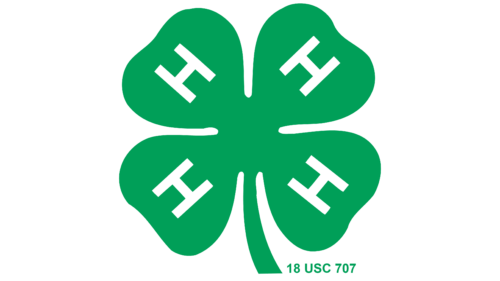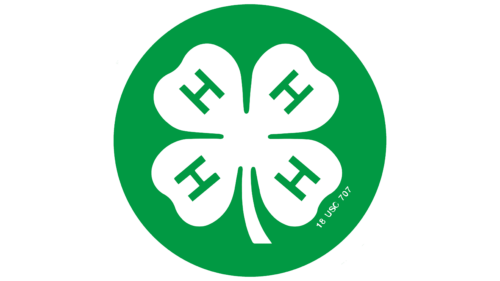Emblem 4h symbolizes luck – an unpredictable coincidence of circumstances that leads to the desired result. It is a hint that the members of the organization will definitely succeed in self-development and career. The balanced shape of the emblem signifies equal opportunities for all.
4h: Brand overview
4h is an organization for youth from 5 to 21 years old, founded in America in 1914. It provides training to help them achieve success in their careers and personal development. The 4h logo unites independently run branches of the organization in 50 countries around the world. In America, about 7 million young people are members of the clubs.
Initially, the movement aimed to teach young people to farm more efficiently, to use modern technology, to take pride in achievements and life in the countryside. In 1902, crop competitions and fairs with prizes began to be organized. In 1912, clubs began to be formed, and in 1914, registration as a national organization took place. After 1970, the direction of the work was greatly expanded.
Meaning and History
The 4h emblem was partially developed in 1910 by Celestia Club educator Josephine Chambaud and adopted in its final four-leaf version in 1911 as the organization’s emblem. The image has remained unchanged since its creation.
The visual mark depicts a four-leaf clover. The usual number of leaves in a clover is 3. They have always been associated with faith, hope, and love. The appearance of the fourth petal – a rare phenomenon. For the one who found it, it is considered a symbol of good luck. Therefore, participation in clubs for children from rural areas becomes the fourth petal, a way to improve their future. Children who have undergone this training (and there are already more than 25 million of them) are more successful in life and are a blessing to their community and country.
What is 4h?
An international American organization for children, adolescents, girls, and boys, aimed at their all-round development for the benefit of the country. It is administered by the National Institute of Food and Agriculture. Headquarters are located in Washington, DC.
Each petal on the emblem has its own special meaning, adopted only in 4h. The first three is Celestia Josephine, the founder of the movement, who organized clubs in 130 rural schools. She saw in the sheets three important components of a healthy and developed human being: head (head), hands (hands), and heart (heart).
Meetings included:
- Receiving information about new technologies, scientific achievements, and organization of the economy for clearer and sober thinking – head.
- Practical exercises to implement the knowledge gained to be ready to work – hands.
- Labor for the benefit of society, helping each other, others, and their rural community, cultivating loyalty to different people – heart.
Thus, the head, hands, and heart were involved in learning. The idea of the fourth petal came later and spread thanks to Oscar Herman Benson, who was given a 4-leaf clover in class. So he decided to use it in the emblem.
In Benson’s understanding, the petal symbolized vanity – energy activity. But fellow activists convinced him to change the meaning and focus on teaching children to take care of themselves, their bodies, and their health. Now, the fourth petal is health.
The number 4 in the logo reflects not only the values of the clubs but also the organization of the classes. They last 4 hours (using three petals; the lessons lasted 3 hours), and the greatest intensity and intensity is in the 4th grade.
All the petals on the logo are equal. They are of the same size and occupy the same space. Thus, a balanced composition is formed. In the same way, in the lives of young people, there should not be a skew to either side; only then a harmonious personality will be formed. The image also demonstrates equality between boys and girls, people of different colors and nationalities. This organization was one of the first to focus on both genders.
In the emblem, each petal is marked with the initial letter of the word it symbolizes. This is how the name 4h came about.
The tail of the leaf is always turned to the right. This speaks of development, movement, and the desire to live honestly.
Font and Colors
The main colors are green and white.
- Green – youth, growth, development.
- White – the beginning, the start of a new generation. Spiritual and moral values – honesty, sincerity.
The quadrangle uses white capital bold letters sans-serif H. They are stable and strong. They symbolize the strength of the young generation. They represent clear, constant rules and values for all members of the organization.
4h Logo Color Codes:
- Dark Red: Hex: #990000; RGB: 153, 0, 0
- Pakistan Green: Hex: #006600; RGB: 0, 102, 0
- Feijoa: Hex: #a4cf88; RGB: 164, 207, 136
- Apple Green: Hex: #5ba43e; RGB: 91, 164, 62
- Deep Green: Hex: #0e700c; RGB: 14, 112, 12
FAQ
What does the 4-H symbol represent?
It depicts a green four-leaf clover with a stem on a white background, with a white or gold-colored “H” on each leaf. These “H’s” stand for “head,” “heart,” “hands,” and “health,” illustrating the educational goals and outcomes 4-H strives to achieve.
What is the 4-H color code?
For graphic designers, the official shade of 4-H clover is designated as 100% PMS 347 green. Acceptable clover colors are green, white, black, and metallic gold, but the emblem must not contain gradients, shades, or multiple shades.
Why is the 4-H symbol a clover?
The transition from the three-leaf clover to the four-leaf clover occurred around 1908. Benson, one of the founders of the organization, specified that the four H’s should stand for “head, heart, hands, and vanity,” emphasizing helpfulness, service, and health.
What does the color green in 4-H stand for?
The color green in the 4-H emblem is an indication of vitality, growth, and youth, while the white background conveys purity and lofty ideals.





